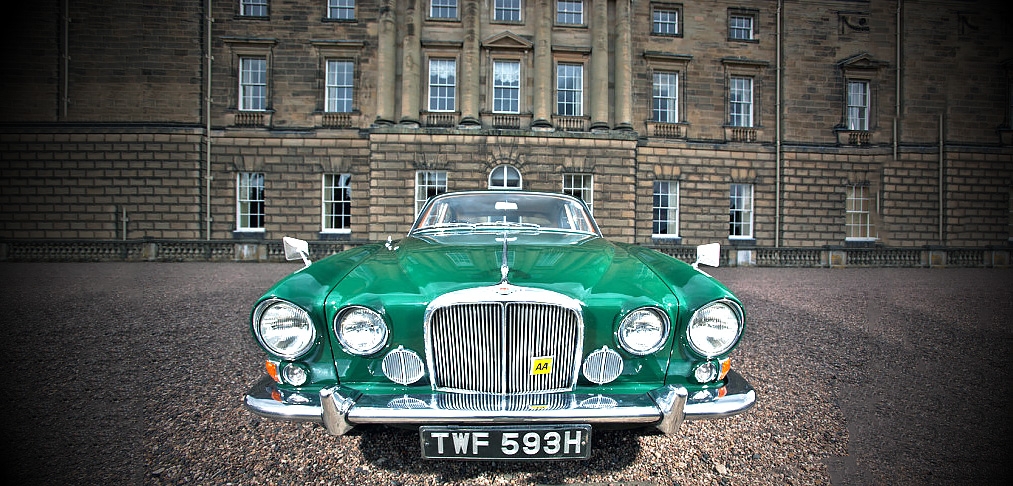
Just over a year has now passed since the Mk. 10 Jaguar was the belle of the 1961 London Motor Show, and our readers’ natural desire, so often expressed, to see a full road test of this striking car has certainly been matched by the test staff’s eagerness to try it.
At last the makers have submitted one for this purpose, and the experience has been well worth the long wait. The car in question was fitted with the optional Borg-Wamer automatic transmission. It hid already covered over 13,000 miles, including two Continental trips, when handed over, but had obviously received reaper maintenance in the Jaguar works and was in near-perfect condition. There was not a body creak or rattle.
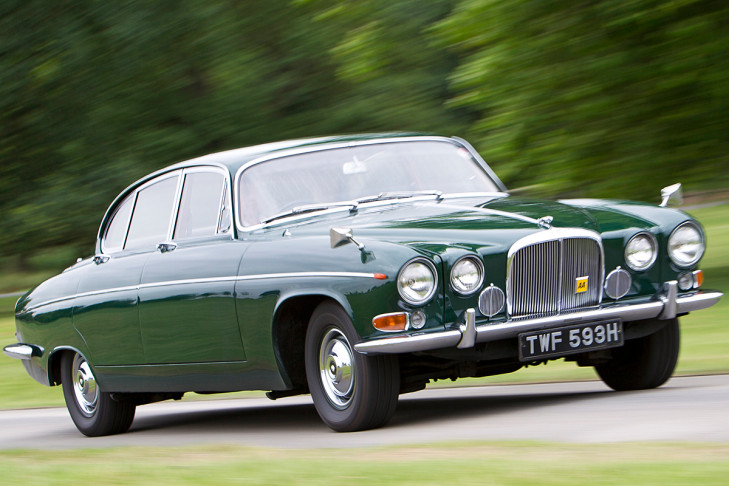
By any standards an impressive vehicle to see on the road, MkX/420G Jaguar is also quite a masterpiece of engineering design and manufacture — even astonishing in relation to its retail price, and almost alone in a class of car which is somewhat void of avant-garde thinking and execution. Its high-efficiency six-cylinder engine with twin overhead cam-shafts is well-enough known, and there is nothing new or outstanding about either the manual gearbox or automatic transmission alternatives; but the independent rear wheel suspension, with its paired coil springs at each side, inboard disc brakes and limited-slip differential, is a highly sophisticated assembly. It is based on that of the E-type sports car.
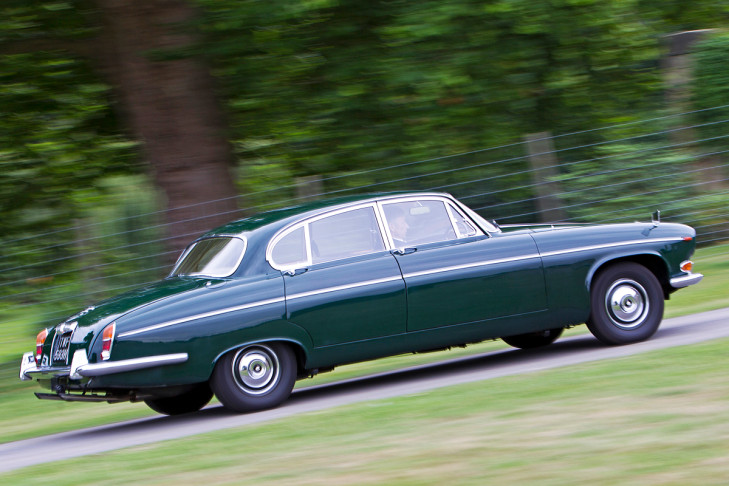
Unmistakably Jaguar in every line, the sleek Mark 10 is only 4ft 6.5in. from road to roof-top.
Other Mk.10 features include Burman power-assisted steering as a standard fitting; two independent 10-gallon fuel tanks, each with its own submerged Lucas fuel pump; separate master cylinders and circuits for the front and rear brakes; a self-adjusting handbrake; vacuum-operated controls for the heating and ventilating system; and a four- headlamp arrangement using 5.75in. inner, long-range lamps paired with 7in. two-filament outers.

While a strong family resemblance is there, the Mk. 10 has practically nothing directly in common with the superseded Mk. 9 in appearance or behaviour. For one thing, the body is no less than 8 ½ in. lower, this being made possible by the fixed transmission line between gearbox and final drive, allowing the rear seat to be dropped accordingly. Having the final drive unit attached to the chassis, thus requiring no clearance for up-and-down movement, has also contributed towards a luggage boot which, rivals those of American cars for capacity.
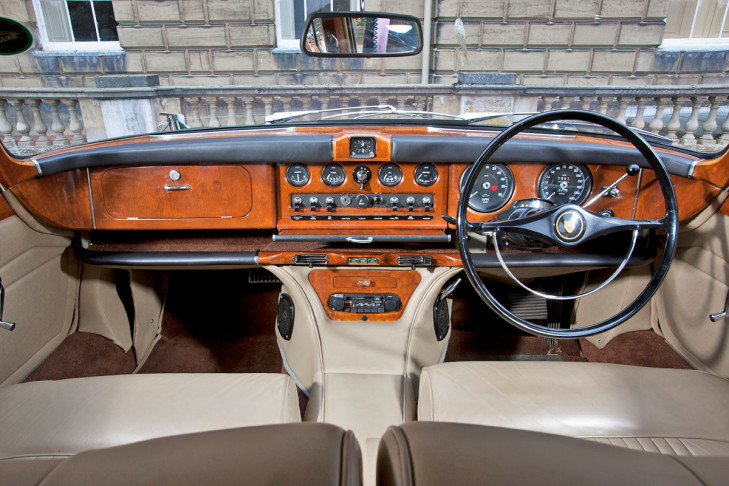
Exceptionally wide — and thick — doors can be a disadvantage in close-parking or narrow garages. Only American cars can rival this one for rear seat width; leg room is also plentiful.
For this model the E-type version of the 3.8-litre engine is installed — considerably more powerful than that of the smaller, current Mk. 2 saloon — with three 2in. S.U. carburettors, an 8.0 to 1 compression ratio and a gross output of 250bhp. Higher and lower ratios are optional, these being 9.0 and 7.0, the former increasing the output to 265bhp. Jaguar are jealous of their reputation for rapid acceleration and a high all-out speed, and since the travelling weight of this car will often exceed two tons (its kerb weight with a half-load of fuel is 37.3cwt), an engine of under four litres capacity must work hard to maintain it. The ability to reach 120mph in slightly favourable conditions, and to accelerate from rest to 100mph in a mean time of 33.3sec, indicate that the reputation has been preserved.
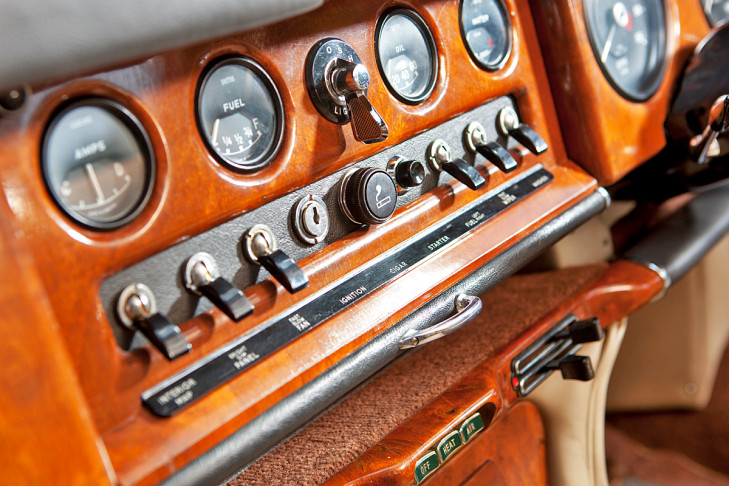
When discussing a Jaguar it is difficult to sidetrack the emphasis from performance and handling qualities to the main purpose of the vehicle now under review, which is to transport five or six passengers in great luxury. To start with, it surely has the widest back seat of any British production saloon — 5ft 6 ½ in. across the cushion and 4ft 9in. at shoulder height. Lengthwise, too, there is much more space than is usual these days, with no prospect of those in the back rubbing knees against the front seats, however long- legged the driver. The aroma of good leather pervades the interior, and this with an abundance of timber veneer gives it almost the cosily affluent air of an Edwardian library.
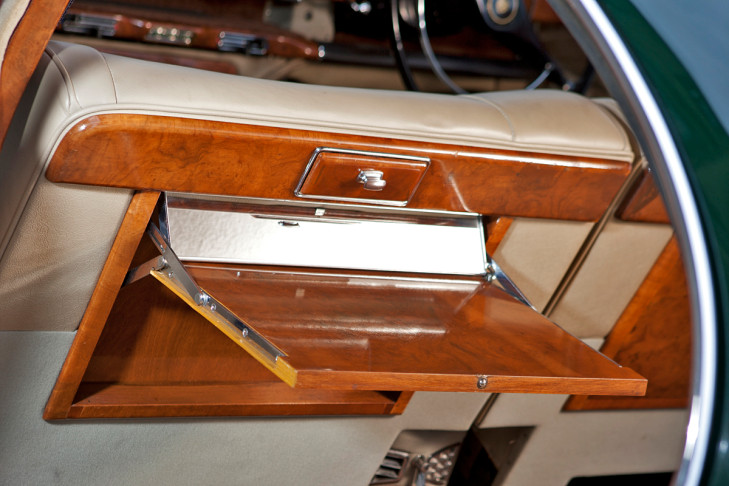
Left: Trimmed all over — including the very accessible spare wheel — the huge luggage boot is deep, easy to load and lit by night. A detachable steel box behind the spare carries a really practical set of good tools. Twin reversing lamps are fitted above the number plate. Right: Reclining front seats allow this unusual view. – While the front compartment is well and truly bisected, at the back a small transmission tunnel scarcely intrudes.
Very wide individual front seats are, indeed, as comfortable as easy chairs in a library while the car is travelling in a straight line. The backrests are adjustable, and can be lowered almost to the horizontal. However, the free width between the doors and the small folding arms in each backrest, together with the absence of any shaping to bolster one against cornering forces, are real drawbacks. Wearing a safety harness (as provided in the test car) counteracts this to some extent, but from the driver’s viewpoint the need for conscious muscular effort to hold himself upright on the slippery trim reduces his control over the steering.
Room at the Back
In the back, too, the seat is basically very soft and comfortable, but a wider centre armrest would be welcomed. Perhaps one is asking too much in suggesting padded headrests in the rear quarters and footrests in the cutaways under the front seats (to provide a more restful angle for the ankles) when the Mk. 10 equipment is next revised. The middle passenger would normally sit with legs splayed and a foot under each front seat. Even so, it is an exceptionally luxurious and roomy V.I.P. lounge, with a direct cold or hot air feed in the middle of the floor. Folding picnic tables, with mirrors, are set in the backs of the front seats, the door windows include both winding glasses and wide, hinged ventilators, and electric window-lifts are among the listed extras. Very wide and deep doors front and rear make it as easy as it could be under the low roof to clamber in and out.
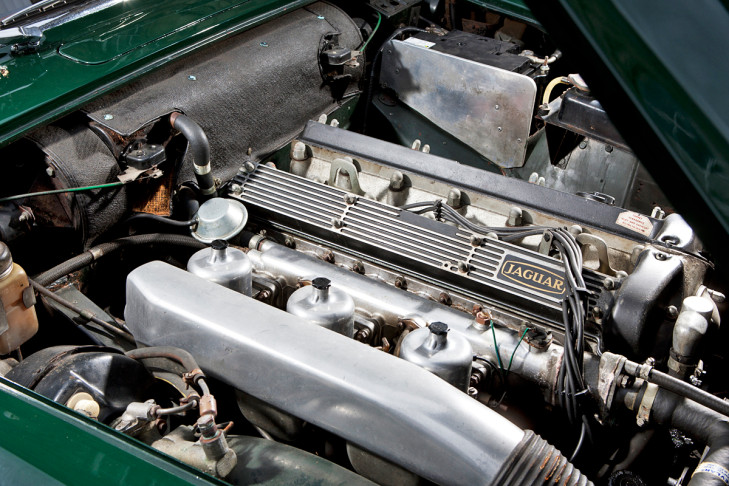
Three big S.U. carburettors and a gold-painted, light alloy cylinder head under polished camshaft covers are centre-pieces of a striking engine-room. In the foreground is the steering pump oil reservoir.
One could do with further places inside the car to stow the odds and ends that go with travel; the more passengers a car can carry, the more the paraphernalia that accumulates. In the dash is a tiny locker; beneath it, a full-width shelf deep enough for little more than an umbrella. Later cars than the one tested do have an open receptacle by the front passenger’s left shin, but there would be plenty of room for door pockets. In the back is only the window shelf.
Main driving controls include two identical levers behind the steering wheel; anyone accustomed to finding the direction signalling lever on the right might put the transmission into reverse while wishing to indicate a right turn. Why not a distinctive knob, at least, on the lever end? The steering-wheel is the customary Jaguar two-spoke with a half-horn ring — neat to look at, comfortable to hold and on a telescopic adjustment.
While the accelerator organ pedal is comfortably angled, there is 45-50 deg. difference between this and the brake pedal in their static positions; the brake pedal’s leading edge is then about 3in. nearer the driver, and its rubber pad shows wear only at this point.
Plain, black-faced instruments with white figures, easy to read and properly calibrated, are in character with the car. Those for fuel level (with a two-way switch, to read for either tank), water temperature and oil pressure are of the bi-metallic electrical type which gives a completely steady reading. The speedometer was nowhere more than 1mph at variance with our towed fifth wheel instrument, and agreed exactly at 120mph A row of six similar tumbler switches (of excellent quality) beneath the centre panel are identified on a neat strip below them, remotely illuminated at night; but one cannot read these when travelling fast, so they have to be memorized. When wearing safety harness, the driver can reach all his controls.
Flexible sun vizors are praiseworthy for having the thick and firm safety padding extended over their hinged spines. A cloth roof lining, with a foam backing which stifles any trace of drumming, may seem out of line with the current trend towards washable plastics; yet it certainly looks the part and had not become dirty in the none-too-new test car. Three interior lamps — one above the rear seat, one above each centre pillar — are of indifferent quality compared with the car’s other fittings.
| GEAR | m.p.h. | k.p.h. |
| TOP (mean) | 119.5 | 192.4 |
| (best) | 120.0 | 193.2 |
| Intermediate: | 82 | 132 |
| Low: | 51 | 82 |
Exceptional quietness is one’s first strong impression when taking the car on the road. It is mechanically unobtrusive, with none of the transmission noise often resulting from having the final drive unit mounted on the body structure; and insulation from road rumble and sympathetic vibrations of the body structure is truly remarkable. One can feel the big tyres thumping over cats’ eyes and road joints, but much less than is usual with large and heavy cars. Wind noise is no problem at any speed, and one can chat without raising voices when cruising at 100mph and over.

A very soft and “expensive” ride, together with almost sports car stability through fast bends and over rough road surfaces, thoroughly justifies the complexity of a superb independent rear suspension. As befits a car in which many a business executive will be driven by his chauffeur, one can write easily and legibly in the back while being whisked along at high speeds. The nature of the suspension and the inherent impression of security in this car are such that passengers are usually unaware that they are travelling as fast as the speedometer indicates.
| 4.9 | 6.7 | 9.1 | 12.1 | 15.1 | 20.6 | 26.3 | 33.3 | 44.9 | TIME IN SECONDS | |
| 30 | 40 | 50 | 60 | 70 | 80 | 90 | 100 | 110 | 120 | TRUE SPEED m.p.h. |
| 30 | 40 | 50 | 61 | 71 | 81 | 91 | 101 | 111 | 120 | CAR SPEEDOMETER |
Almost neutral steering characteristics have been achieved, and the Dunlop RS5 tyres cling tenaciously to the road, wet or dry, without squeal. After a slight initial tilt, there is negligible roll when cornering — it scarcely seems to increase with speed — but at times one could wish for stronger damping to counteract slow-rate, longitudinal “plunge,” as distinct from “pitch;” but this is never excessive.
Performance figures which are tabulated on page 791 speak for themselves; they were taken, of course, without the physical exertion of moving a gear lever or clutch pedal, and with little mechanical fuss except when accelerating hard up to high engine speeds in the indirect gears. While the normal full-throttle change points occur at around 40 and 70mph (low to intermediate and thence into top), there are manual holds which set no limit to engine revs. While these allow the car to exceed 50 and 80mph respectively, this practice does not improve standing-start acceleration times. The Borg-Warner transmission is never completely unobtrusive in its actions except when changing down at very low speed on the overrun; at best, upward changes are marked by a slight surge. Least welcome habit is the jerky, unwanted change into top when one has accelerated hard in intermediate and then released the throttle, as happens frequently in heavy traffic; but this can be avoided by using the intermediate hold switch. There is the usual kick-down switch under the accelerator for instant downward changes below the governed maxima.

Jaguar MkX automatic transmissions with fluid couplings always make light work of the restarting exercise on the 1-in-3 test hill and, with a torque converter supplemented by a limited-slip differential, no care need be taken to avoid wheelspin. On this slope the handbrake could not quite hold the ear, but it was quite secure on 1-in-4.
Braking tests are often the most frustrating part of a road test, either because early wheel-locking complicates the operation or because an excellent system does not always produce a spectacular retardation from 30mph About the Mk. 10’s brakes there are no reservations. They behave marvellously in normal road use, and during our test returned a 1.0g maximum retardation at every attempt — for a pedal load of only 60lb. They did not make the tyres squeal or pull the car off-course, and there was no fade.
| Speed range and time in seconds | |||
| Mph | Top | Inter | Low |
| 10—30 | — | — | 3.8 |
| 20—40 | — | 5.6 | 4.0 |
| 30—50 | 9.7 | 6.2 | 4.5 |
| 40—60 | 10.1 | 6.2 | — |
| 50-70 | 9.7 | 6.8 | — |
| 60—80 | 10.8 | 8.4 | _ |
| 70—90 | 11.9 | — | _ |
| 80—100 | 12.7 | — | _ |
| 90—110 | 18.6 | — | — |
| BRAKES | |||
| Pedal Load | Retardation | Equiv. distance | |
| (from 30 m.p.h. in neutral) | 25lb | 0.35g | 86ft |
| 50lb | 0.75g | 40ft | |
| 60lb | 1.0g | 30.2ft | |
| Handbrake | 0-35g | 86ft | |
Reactions among the test staff to the power-assisted steering were mixed, but the synopsis of opinion was broadly as follows. Most important, it improves with acquaintance; and about the ease of parking (aided by excellent steering locks) there was no dispute. But it was voted too low-geared about the straight-ahead position, and at slow speeds lacks the sensitivity that makes for relaxation. The faster one goes, the better it is (which is as it should be for a fast car), and inherent directional stability takes any strain out of motorway driving. Reaction to steering-wheel movement is a bit slow when entering a fast bend, so that one learns to anticipate this and also to be prepared to unwind slightly once the car has entered the chosen path; then it will hold its course tidily without further correction. This is, perhaps, over-elaborating on a mechanism which will certainly please most owners.
One cannot expect to carry so many people so fast without paying a substantial fuel bill, yet the overall consumption of 14.1mpg for 1,043 hard test miles is very reasonable, all things considered. Most owners can expect to do better than this over a long mileage. At a steady 80mph nearly 16 miles are covered on a gallon, but at 100mph one of the 10-gallon tanks would be drained within the hour. Having two quite separate fuel tanks is a great convenience in several respects, and the 20-gallon capacity is adequate. When refilling both tanks it is a nuisance to have to unlock two fillers. A leak developed in the radiator towards the end of the test, and almost simultaneously an electrical fault in the intermediate hold switch of the automatic transmission twice put this out of action, with eight other circuits served by the same fuse.
Below the radio are three push-buttons for ventilation and heating, powered by a reservoir evacuated by engine induction; they read Off, Heat and Air. The middle one controls the tap to the heater matrix and flaps admitting air to this; pressing the Air button opens a flap on the scuttle. The third button has the reverse effect. One can have Heat without Air to warm and recirculate air already in the car, but there is no progressive temperature control, although quantity can be varied by two-speed boosters.
Below the facia at each side are adjustable outlets for cool or warmed air to the feet or body; a separate feed above the transmission tunnel and between the front seats, with an on-off lever, directs a powerful flow into the rear compartment. Closer control over delivery temperature is needed, and the test car’s engine ran too cool — rarely above 70 deg. C. (158 deg. F.) — for wintry conditions, but it is a big advance over previous Jaguar systems.
Among the standard fittings is an excellent Radiomobile receiver with speakers front and rear, the telescopic aerial being raised or lowered by a winding handle under the facia. Paired headlamps are in keeping with the car’s potential speed, although the dipped beams are not better than average. The two-speed wipers clean a large area, are effective at speed and very quiet. With the Jaguar comes a very comprehensive and well-arranged handbook, with many clear drawings including full technical data. The car calls for quite a lot of periodic maintenance and checking — but, after all, a Mk. 10 is quite a lot of car. It is one of the proudest products of British industry.
| Test Conditions | ||
| Weather Dry, overcast, with 4-8 m.p.h. wind | ||
| Temperature 16.7 deg. C. (62 deg. F.) | ||
| Barometer 29.9in. Hg. | ||
| Dry concrete and tarmacadam surfaces. | ||
| Weight | ||
| Kerb weight (with oil, water and half-full fuel tank) 37-3cwt (4,179lb – 1,895kg) | ||
| Front-rear distribution, per cent F, 53-4; R, 46-6 | ||
| Laden as tested 40-3cwt (4,5l5lb-2,048kg) | ||
| Turning Circles | ||
| Between kerbs L, 39ft 2in.; R, 40ft 3in. | ||
| Between walls L, 41ft 5in; R, 42ft 4in. | ||
| Turns of steering wheel lock to lock 3.7 | ||
| Performance Data | ||
| Top gear m.p.h. per 1,000 r.p.m 21.2 | ||
| Mean piston speed at max. power 3,500ft/min | ||
| Engine revs, at mean max. speed 5,500 r.p.m. | ||
| B.h.p. per ton laden (gross) 124 |
| Car | 1962 Jaguar MkX |
| Made in | UK |
| ENGINE | |
| Type | Jaguar R6 |
| Cylinders | 6 in line |
| Bore Stroke | 87mm (3.43in.) 106mm (4.17in.) |
| Displacement | 3,781 c.c. (230.6 cu. in.) |
| Valve gear | Twin overhead camshafts |
| Compression ratio | 8.0 to 1 |
| Carburettors | Three 2in. S.U. HD8 with automatic mixture control for cold-starting |
| Fuel pump | Two Lucas 2FP, one immersed In each tank |
| Oil filter | Tecalemit ftill-flow, replaceable element |
| Max. power | 250 b.h.p. (gross) at 5.500rpm |
| Max. torque | 250 lb. ft. (gross) at 4.000rpm |
| TRANSMISSION | |
| Gearbox | Borg-Warner three-speed automatic with torque converter |
| Overall ratios |
Top, 3.54; Inter, 10.95-5.08; Low, 17.6-8.16; Reverse 13.36-6.21 |
| Final drive | Salisbury hypoid bevel 3.54 to 1 with PowrLok limited-slip differential |
| CHASSIS | |
| Construction | Integral with steel body |
| SUSPENSION | |
| Front | Semi-trailing wishbones and coil springs, Girling telescopic dampers, anti-roll bar |
| Rear | Independent; lower tubular links and fixed length drive shafts for transverse location. Longitudinal location by radius arms. Two coil springs and Girling telescopic dampers at each side |
| Steering | Burman power-assisted, recirculating ball type. Wheel dia., 17in. |
| BRAKES | |
| Type | Dunlop bridge-type discs, outboard F, inboard R, with Kelsey-Hayes vacuum servo assistance and separate circuits |
| Disc diameter | F and R F, 10.75in.; R 10.0in. |
| Total swept area | 561 sq in. (278 sq in. per ton laden) |
| WHEELS | |
| Type | Dunlop pressed steel bolt-on, 5 studs, 5.5in. wide rim |
| Tyres | Dunlop RS5 7.50 — Min. with tubes |
| EQUIPMENT | |
| Battery | 12-volt 67 amp. hr. |
| Headlamps | Four Lucas sealed beam units; 7in. outer, 60/45 watts; 5-75in. inner, 37.5 watts |
| Reversing lamps | Two automatic |
| Electric fuses | 8 |
| Screen wipers | Two, self-parking two-speed |
| Screen washers | Lucas electric Fresh air type with twin two-speed electric boosters |
| Interior heater | Built-in anchorages provided |
| Safety belts | Leather seats, cloth roof lining bonded to foam rubber backing |
| Interior trim | Pile carpet |
| Floor covering | No provision |
| Starting handle | Screwed pillar with winding handle |
| Jack | Two each side below body sills |
| Jacking points | None |
| Other bodies | |
| MAINTENANCE |
|
| Fuel tanks | Two, total 20 ;mp. gallons no reserve |
| Cooling system | 24.5 pints (including heater) |
| Engine sump | 13 pints (inc. filter) SAE30 (summer), SAE20 (winter). Change oil every 2,500 miles; Change filter element every 5,000 miles |
| Automatic transmission and torque converter | 15 pints. Change oil every 10,000 miles |
| Final drive | 2.75 pints SAE 90. Change oil every 10,000 miles |
| Grease | 12 points (drive shaft universals and steering) every 2,500 miles; 6 points (rear suspension) every 5,000 miles |
| Tyre pressures | F, 28; R, 25 p.s.i. (normal driving) F, 28; R, 28 p.s.i. (full load) F, 32; R, 30 p.s.i. (fast driving) F, 32; R, 32 p.s.i. (fast, full load) |





